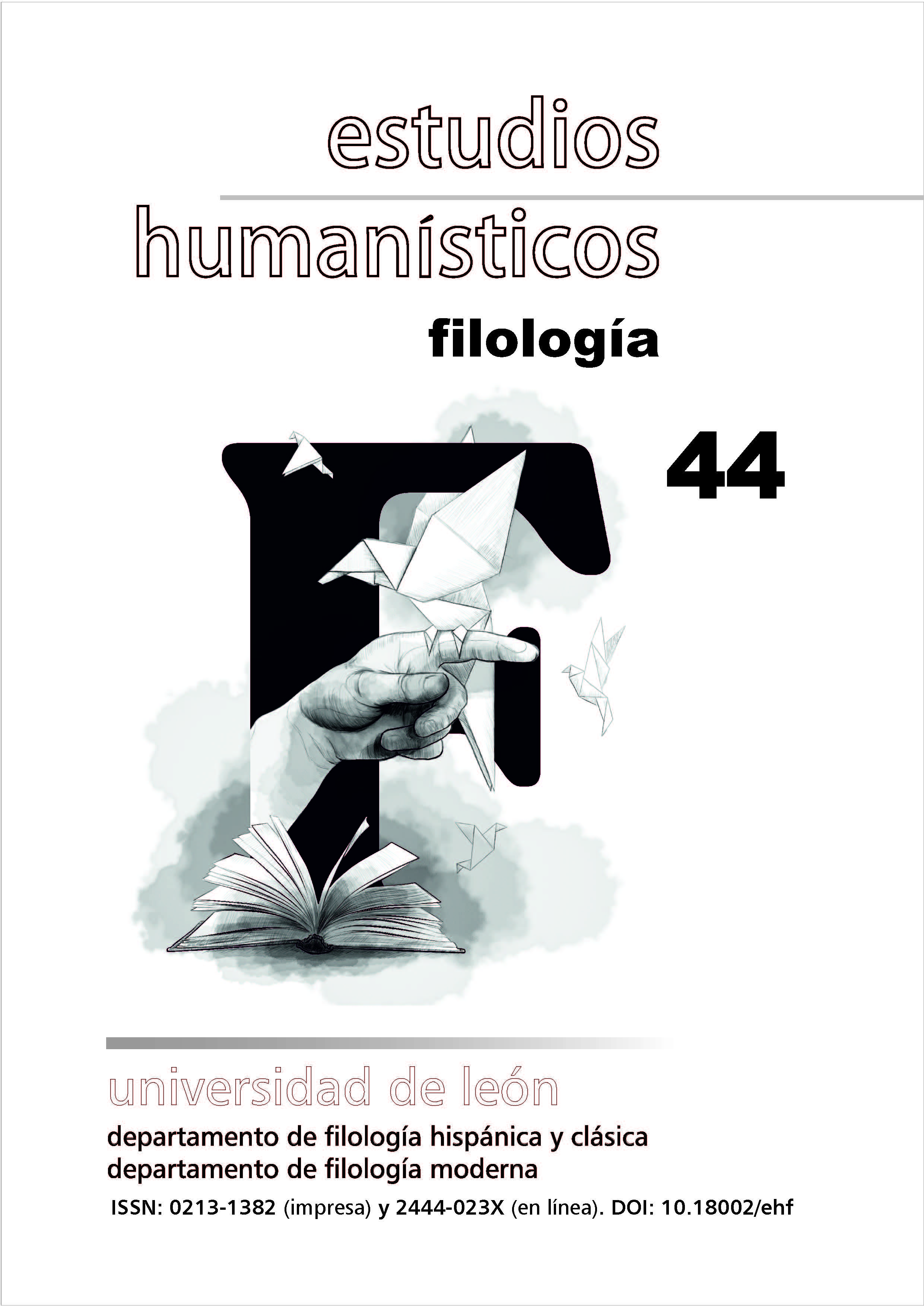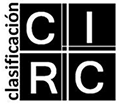Textos multimodales y tareas de traducción en español como lengua extranjera: la adquisición del clítico se por parte de adultos de habla holandesa
DOI:
https://doi.org/10.18002/ehf.i44.7363Palabras clave:
hablantes de holandés, español como lengua extranjera, clítico se, audiodescripción, doblajeResumen
En este artículo se presentan los resultados de un estudio experimental sobre la adquisición del clítico se por parte de estudiantes belgas neerlandófonos que estudian el español como lengua extranjera en el tercer año del Departamento de Traducción, Interpretación y Comunicación de la Universidad de Gante. Basándose en una secuencia sacada de la película anglófona The Help (Taylor, 2011), un grupo de 35 participantes belgas llevaron a cabo dos tareas: una traducción intersemiótica (crearon un guion audiodescrito del clip en español), y una traducción interlingüística (tradujeron los diálogos ingleses al español).
Descargas
Métricas alternativas
Citas
Ajayi, L. (2009): “English as a Second Language Learner’s Exploration of Multimodal Texts in a Junior High School”, Journal of Adolescent and Adult Literacy, 52(7), 585-595.
Anstey, M. and Bull, G. (2010): “Helping Teachers to explore multimodal texts”, Curriculum and Leadership Journal. An electronic journal for leaders in education,8(16).http://www.curriculum.edu.au/leader/vol8_no16,29838.html?issueID=12141
Beltramelo, A. (2019): “Exploring the Combination of Subtitling and Revoicing Tasks: A Proposal for Maximising Learning Opportunities in the Italian Language Classroom”, International Journal of Language, Translation and Intercultural Communication, 8, 93-109. https://doi.org/10.12681/ijltic.20279
Bosque, I. y Gutierrez-Rexach, J. (2009): Fundamentos de sintaxis formal, Madrid: Akal.
Calduch, C. and Talaván, N. (2018): “Traducción audiovisual y aprendizaje del español como L2: el uso de la audiodescripción”, Journal of Spanish Language Teaching, 4 (2), 166–180.
https://doi.org/10.1080/23247797.2017.1407173
Chaume, F. (2004): “Discourse Markers in Audiovisual Translation”, Meta, 49 (4), 843-855. https://doi.org/10.7202/009785ar.
Council of Europe (2020): Common European Framework of Reference for Languages; Learning, teaching, assessment. Companion volume. Strasbourg: Council of Europe, www.coe.int/lang-cefr
Curry, P. and Sherry, R. (2004): The Hidden Value of Higher Education Learning: Transferable Skills and their Importance for Graduates of Modern Language Programmes. Dublin: Transferable Skills Project.
De Miguel, E. (1999): El aspecto léxico. I. Bosque y V. Demonte (Eds.) Gramática descriptiva de la lengua española. Madrid: Espasa Calpe, 2977-3060.
Devís Márquez, P.P. (2020): “Estados, transitividad y clíticos”. Nueva Revista de Filología Hispánica (NRFH), 68(1), 3-46. https://doi.org/10.24201/nrfh.v68i1.3581
Ellis, R. (2003). Task-based language learning and teaching. Oxford: Oxford University Press.
Escobar, M.A. (2017): “L2 acquisition of Spanish dative clitics by English and Dutch learners”. Studies in Second Language Learning and Teaching, 7(3), 517-534. https://pressto.amu.edu.pl/index.php/ssllt/article/view/9513/9198
Escobar, L. and Torrens, V. (2007): “On the acquisition of clitic se and aspect in Spanish”, in S. Baauw et al. (eds.) (2007) The Acquisition of Romance languages. Utrecht, Netherlands Graduate School of Linguistics, 3: 59-71.
Escobar, L. and Teomiro, I. (2016): “The gradual acquisition of clitic se in Spanish L2”, Topics in Linguistics, 17(1), 17-29. https://sciendo.com/pdf/10.1515/topling-2016-0002
Gee, J. P. (2003): What video games have to teach us about learning and literacy, New York, Palgrave MacMillan.
Heiss, C. (2004): “Dubbing Multilingual Films. A new Challenge?” Meta, 49 (1), 208-220. https://doi.org/10.7202/009035ar
Hyks, V. (2005): “Audio Description and Translation. Two related but different skills”. Translating Today, 4, 6-8.
Ibáñez Moreno, A. y Vermeulen, A. (2014): “La audiodscripción como recurso didáctico en el aula de ELE para promover el desarrollo integrado de competencias”, in R.Orozco (ed.) (2014) New Directions in Hispanic Linguistics, Newcastle upon Tyne, Cambridge Scholars Publishing: 264-292.
Ibáñez Moreno, A. and Vermeulen, A. (2015): “Using VISP (Videos for Speaking), a Mobile App Based on Audio Description, to Promote English Language Learning: A Case Study”. Procedia, Social and Behavioural Sciences, 178, 132–138. https://doi.org/10.1016/j.sbspro.2015.03.169
Ibáñez Moreno, A. and Vermeulen, A. (2017): The ARDELE Project: Controlled Empirical Research on Audio Description as a Didactic Tool to Improve (Meta)linguistic Competence in Foreign Language Teaching and Learning. J. Díaz Cintas and K. Nikolic (eds.) (2007) Fast-Forwardig with Audiovisual Translation, Bristol, Multilingual Matters, 195-211.
Ibáñez Moreno, A. and Vermeulen, A. (2018): “Audio Description for All: a Literature Review of its Pedagogical Values in Foreign Language Teaching and Learning”. Encuentro, 26, 52-68.
Jiménez Hurtado et al (2012): “Museos para todos: la traducción e interpretación para entornos multimodales como herramienta de accesibilidad universal.” MonTI. Monografías de Traducción e Interpretación, 4, 349-383.
https://doi.org/10.6035/MonTI.2012.4.15
Kempchinsky, P. (2004): “Romance se as an aspectual element”. J. Auger et al (eds.) (2004) Contemporary Approaches to Romance Linguistics. Amsterdam: John Benjamins: 239-256.
Knobel, M. and Lankshear, C. (2007): “Online memes, affinities, and cultural production”. M. Knobel and C. Lankshear (eds.) (2007). A new literacies sampler, Frankfurt del Main, Peter Lang Publishing: 199-227.
Lertola, J. (2018): “From translation to audiovisual translation in foreign language learning”, Trans. Revista de Traductología, 22, 185–202. https://doi.org/10.24310/TRANS.2018.v0i22.3217
Lertola, J. (2019): Audiovisual translation in the foreign language classroom: applications in the teaching of English and other foreign languages. Viollans: Research-publishing.net, https://doi.org/10.14705/rpnet.2019.27.9782490057252
Lertola, J. and Mariotti, C. (2017): “Reverse dubbing and subtitling: Raising pragmatic awareness in Italian English as a second language learners”, The Journal of Specialised Translation, 28, 103–121. https://jostrans.org/issue28/art_lertola.pdf
Littlewood, W. (2004): “The task-based approach: some questions and suggestions”, ELT Journal, 58(4), 319-326.
Navarrete, M. (2020): “The use of Audio Description in Foreign Language Education: A Preliminary Approach”, in L. Incalcaterra et al (eds.) (2020) Audiovisual Translation in Applied Linguistics. Educational Perspectives, Amsterdam, John Benjamins: 131–152. https://doi.org/10.1075/bct.111.ttmc.00007.nav
Navarrete, M. (2021): Active audio description as a didactic resource to improve oral skills in foreign language learning. PhD Thesis, UNED.
Romero Fresco, P. (2009): “Naturalness in the Spanish Dubbing Language: a Case of Not-so close Friends”, Meta, 54, 49-72. https://doi.org/10.7202/029793ar
Salway, A. (2007): “A corpus-based analysis of audio description”, in J. Díaz Cintas et al (eds.) (2007) Media for All: Subtitling for the deaf, audio description, and sign language, Amsterdam, Rodopi: 151–174.
Sánchez Requena, A. (2016): “Audiovisual Translation in Teaching Foreign Languages: Contributions of Dubbing to Develop Fluency and Pronunciation in Spontaneous Conversations”. Porta Linguarum 26: 9-21.
Sanz, M. (2000): Events and Predication, Amsterdam: John Benjamins.
Talaván, N. (2019): “Creative audiovisual translation applied to foreign language education: a preliminary approach”, Journal of Audiovisual Translation, 2(1), 53-74.
https://www.jatjournal.org/index.php/jat/article/view/57
Talaván, N. and Ávila-Cabrera, J.J. (2015): “First Insights into the Combination of Dubbing and Subtitling as L2 Didactic Tools”, in A. Caimi and C. Mariotti (eds.) (2015) Subtitles and Language Learning, Oxford: Peter Lang: 149-172.
Talaván, N. and Lertola, J (2016): “Active Audio Description to Promote Speaking Skills in Online Environments”. Sintagma, 28, 59-74.
Teomiro, I. (2013): “Low applicatives and optional se in Spanish non-anticausative intransitive verbs”. Revista de Lingüística y Lenguas Aplicadas, 8, 248-270.
Teomiro, I. and Romero, C. (2012): “Theta meets aspect: The Spanish aspectual se with consumption verbs”, Topics in Linguistics, 10, 20-27.
Vermeulen, A., and Ibáñez Moreno, A. (2017): “Audio description as a tool to promote intercultural competence”, in J. Deconinck et al (eds.) (2017) Towards Transcultural Awareness in Translation Pedagogy. Wien: LIT Verlag: 133-153.
Vermeulen, A. and Escobar, M.A. (2021): “Audiovisual Translation (Dubbing and Audio Description) as a Didactic Tool to Promote Foreign Language Learning: The Case of Spanish Clitic Pronouns”, Translation and translanguaging in multilingual contexts, 7(1), 86-105. https://doi.org/10.1075/ttmc.00060.ver
Zabalbeascoa, P. (2008): The Didactics of Audiovisual Translation, Amsterdam: John Benjamins: 21-37.
Descargas
Publicado
Cómo citar
Número
Sección
Licencia
Derechos de autor 2022 María Ángeles Escobar Álvarez, Anne Vermeulen

Esta obra está bajo una licencia internacional Creative Commons Atribución-NoComercial-CompartirIgual 4.0.
Los autores o autoras que publican en esta revista están de acuerdo con los siguientes términos:
- Los autores o autoras conservan los derechos de autoría de su trabajo y ceden de forma no exclusiva los derechos de explotación (reproducción, distribución, comunicación pública, transformación) a la Universidad de León, por lo que pueden establecer, por separado, acuerdos adicionales para la distribución no exclusiva de la versión de la obra publicada en la revista (por ejemplo, alojarlo en un repositorio institucional o publicarlo en un libro), con un reconocimiento de su publicación inicial en esta revista.
- Este trabajo se encuentra bajo la Creative Commons Attribution-NonCommercial-ShareAlike 4.0 International License. Puede consultarse desde aquí la versión informativa y el texto legal de la licencia.
- Se permite y se anima a los autores y autoras a difundir electrónicamente las versiones pre-print (versión antes de ser evaluada) y/o post-print (versión evaluada y aceptada para su publicación) de sus obras antes de su publicación, ya que favorece su circulación y difusión más temprana y con ello un posible aumento en su citación y alcance entre la comunidad académica.











